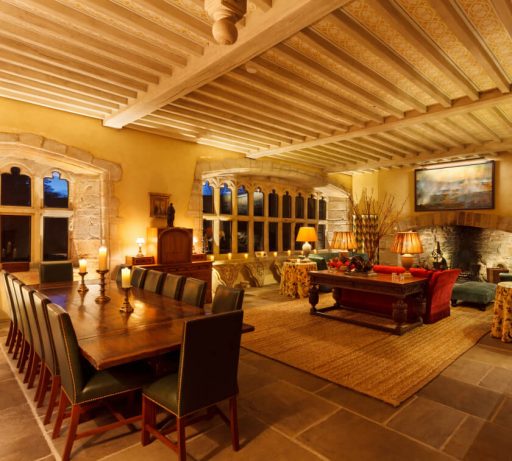
Lighting a 15th Century barn
We’re lucky to have the chance to work on the most magnificent buildings. Lighting this barn has been challenging, fun and educational in equal measure.
Very tall ceilings – and sometimes double or triple height spaces – are increasingly common. Historic houses and churches on a grand scale have always been with us, but contemporary architecture and contemporary conversions often include stunning, airy spaces.
In addition to the challenges of height, these high ceiling spaces often offer only limited fixing points due to ornate plasterwork ceilings, no ceiling void spaces or substantial areas of glazing. All of these are wonderful in daylight, but present both opportunities and challenges for artificial lighting, and for control of natural light.
Building up different layers of lighting is always important but even more so when lighting high ceilings. One common mistake is just to mount everything into or onto the ceiling and blast or dribble light down from there. Another is solely to light upwards from walls, floors or beams and lose the surfaces below in darkness. Both of these routes result in spaces which are uncomfortable or impractical to be in and do nothing to enhance the architecture or interior design.
There’s no one right answer to the best design but the start point is to understand the space as a whole: what’s interesting about it, where do you want your eye to go, what task lighting is required, and what are all the available fixing points. These might be ceilings, floors, walls, joinery. Remember the ‘human scale’; curling up on a sofa with a brightly lit up ceiling 5m above you might be interesting but isn’t cosy. The same space with a subtly lit ceiling, creatively lit bookshelves, glowing artwork and pools of light over the sofa from lamps would be warm and luxurious.
Early planning means that where fixing points in the right places aren’t immediately obvious, they can be created as part of an overall design. Light fittings can be tailored or completely bespoke designs can be created.
In this kitchen in a stately home which we did in 2011, the ceilings are c.3.5m high. There is almost no lighting in the ceiling, but excellent functional light is provided by concealing punchy linear fittings in the kitchen joinery, and, over the island, by designing the pan rack around excellent quality, long lasting fittings in the corbels of the rack.
This lovely, large, family dining area is in the glazed area of a kitchen/dining/living space. There are very few obvious mounting points for lighting; most of the available space is glazed. We worked with the window company and builders to develop custom mounting points on the glazing bars supplemented with additional LED lighting set into the floor.
The result is atmospheric lighting for the dining room with the option of soft coloured LED lighting as a backdrop when the space is not in use.
Aesthetically and practically, higher output fittings are often needed simply to cope distances whilst keeping the quantities of fittings low. Glare control and beam angles are important especially if floor mounted. Being creative with fixing points can often mean an unusual fixing method is required, or very tiny fittings in sympathetic finishes may be needed to “disappear” into the fabric of the building/interiors.
With limited fixing points, pendants and wall lights are often required to be primary light sources in their own right as well as looking decorative. The light source and the quantity, quality and shape of the light distribution should be a key part of the selection criteria. Traditional lamps (e.g. G9, E14 or E27 ‘bulbs’) often just don’t cut it when task lighting is required. Fortunately there is a blossoming of striking contemporary light fittings with excellent light. We can also create bespoke fittings if appropriate.
Reliability, longevity and maintenance are always important, but again particularly so in unforgiving spaces where fittings may be hard to reach. Failure can be minimised with the right kit. Longevity and proven reliability are key criteria we use when selecting fittings for projects. We use light sources with calculated lifetimes of up to 426,000 hours (L70). Remote drivers which might require replacement can be located in accessible places.
Tall spaces are often complex spaces with multi-functional uses. Having designed your beautiful multi-layered lighting scheme that is able to zone in and shift the focus between areas depending on time of day and usage, how do you control it? Conventional control with banks of switches or dimmers is likely to be confusing and frustrating. A well designed and programmed lighting control system should be intuitive to use. A single button press should take you from a cooking scene to a dining scene to a late night TV watching scene, changing the space from practical to dramatic to cosy.
Tall spaces often have tall windows, which again can be problematic to curtain or blind conventionally. Early planning enables electric curtain or blind solutions to be integrated seamlessly into a space. It makes them a joy to use as well as providing additional security and thermal control.







